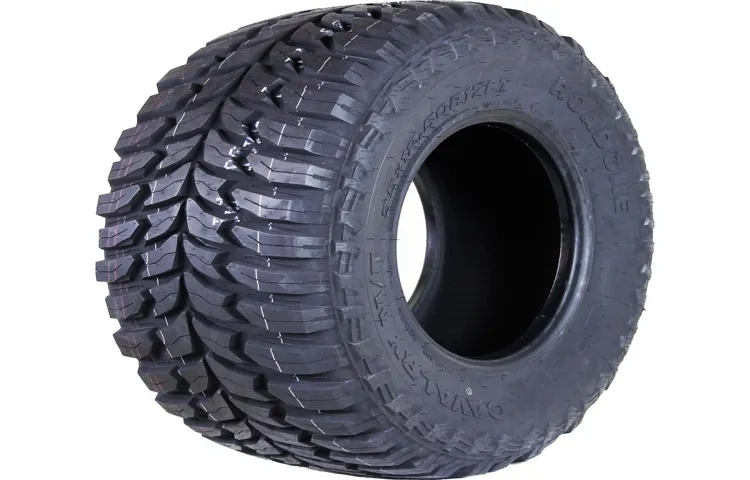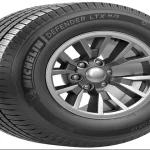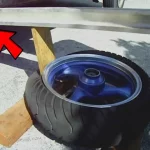Do you know what a blem tire is? If you’re not familiar with this term, you’re not alone. Blem tires can be a mystery to many drivers, yet they are a common type of tire that is often sold at a discounted price. Blemished tires, also known as “factory seconds,” are tires that have some sort of cosmetic defect, such as a small scratch or discoloration.
These tires are still safe to use on the road and offer the same level of performance as a non-blemished tire. In fact, the cosmetic defect is often so minor that it’s barely noticeable. But why are these tires sold at a lower price? And should you consider buying them? Let’s explore the world of blem tires together and discover what advantages they offer.
Table of Contents
Definition of Blem Tire
A blem tire is a tire that has a cosmetic or visual flaw but is still structurally sound and safe to use. The flaw could be caused by a manufacturing defect, like an air pocket in the rubber, or by damage during shipping or handling. Blem tires are often sold at a discounted price, making them an attractive option for budget-conscious drivers.
However, it’s important to note that blem tires may not come with the same warranty coverage as new tires, and the extent of the damage can vary. It’s always a good idea to inspect blem tires carefully before buying them and to ensure that any imperfections won’t affect their performance or safety on the road. So, if you’re looking for a good deal on tires and don’t mind a minor cosmetic flaw, a blem tire may be worth considering.
Blemish
Blemish is a term used to describe any imperfection on the surface of an object. When it comes to tires, a blem tire refers to a tire that has a cosmetic flaw that doesn’t impact its safety or performance. This can include irregular tread patterns, scuffs, or cosmetic marks.
Blem tires are often sold at a reduced price since they don’t meet the aesthetic standards of the manufacturer. However, it’s important to note that blem tires should not be confused with retreads, which are tires that have been repaired and in some cases, can affect the performance of the tire. When purchasing blem tires, it’s essential to ensure that the flaws don’t impact the tire’s safety or performance, and it’s always recommended to purchase from a reputable dealer.
So, whether you’re looking for a bargain or simply don’t mind a few blemishes, blem tires can be a great option for your vehicle, as long as they’re checked carefully before installation.

Cosmetic Blemish
A cosmetic blemish on a tire refers to any imperfection on the surface of the tire that does not compromise its structural integrity or performance. It could be a small scratch, a scuff mark, or discoloration caused by a manufacturing defect or wear and tear. Such blemishes are considered cosmetic because they do not impair the overall function of the tire and are purely aesthetic in nature.
While they may not affect the tire’s performance, blemishes may affect its resale value or the overall appearance of a vehicle. Manufacturers usually have strict guidelines on the acceptable level of cosmetic blemishes on tires and provide warranties to cover such defects. It’s essential to note that although cosmetic blemishes do not affect the operational performance of a tire, more severe damages such as bulges or punctures can have a significant impact, especially if left unaddressed.
Therefore, owners must check their tires regularly, including the presence of any cosmetic blemishes, and have them repaired or replaced when necessary.
Types of Blem Tires
Blemished tires can be a great way to save some money on your tire purchase, but it’s important to understand what they are. Essentially, a blem tire is a tire that has some sort of cosmetic blemish or imperfection that prevents it from being sold as new. These imperfections might include scuffs, scratches, or other types of marks on the tire’s surface.
There are several types of blem tires, including those that have been rejected due to appearances, those that have been returned by customers, and those that have been discontinued. While blem tires might not look perfect, they’re usually just as safe and perform just as well as new tires. However, it’s important to make sure that the blemish won’t affect the tire’s performance before making a purchase.
Overall, if you’re looking to save some money on your tire purchase, a blem tire might be a great option for you.
Factory Blem Tires
Factory blem tires, also known as factory seconds or cosmetic blemish tires, are brand new tires that have minor cosmetic imperfections. These imperfections don’t affect the performance or safety of the tire but are often a result of the manufacturing process. There are different types of blem tires, including those with cosmetic defects such as scuffs, scratches, or cosmetic blemishes on the tread or sidewall.
Other types of blem tires may have minor variations in the tread thickness or slightly irregular wear patterns, but these are still safe for use on the road. Blem tires are often sold at discounted prices, making them an affordable alternative to new tires for those looking to save money. They are a smart choice for drivers who aren’t too concerned about the visual appearance of their tires.
Overall, blem tires offer great value to drivers who prioritize affordability over perfection.
Customer Return Blem Tires
If you’re looking for a way to save some money on new tires, you might want to consider blemished tires. These are tires that have some sort of cosmetic imperfection, such as a scratch or a scuff, but are still perfectly safe to use. There are two main types of blem tires.
The first is a customer return blem tire. This is a tire that a customer bought, but then returned because they were unhappy with it for some reason. The tire is inspected to make sure it is still safe to use, and then sold at a discounted price.
The second type of blem tire is a factory second. These are tires that didn’t meet the manufacturer’s strict quality standards for some reason, but are still safe to use. They typically have a small “x” or dot on the sidewall to indicate that they are blemished.
While blem tires might not be the prettiest tires on the road, they can be a great way to save money if you’re on a tight budget. Just make sure to inspect them carefully before buying to ensure that they are safe to use on your vehicle.
Discontinued Model Blem Tires
If you’re in the market for new tires, or just looking for a great deal, then you might want to consider blemished tires. Blemished tires are essentially brand new tires that have some cosmetic defects. These tires can be a great way to save money while still getting quality tires.
However, it’s important to note that not all blemished tires are created equal. There are several different types of blemished tires, each with their own specific defects. Some common types of blemished tires include tires that have cosmetic defects like scuffs or scratches, tires that have slight bulges or deformations, and tires that have been discontinued but still have plenty of life left in them.
If you’re interested in purchasing discontinued blem tires, you may want to act quickly as these tires are often in high demand and can sell out fast. Regardless of the type of blemished tire you choose, make sure you get them from a reputable dealer that can give you warranty coverage.
Are Blem Tires Safe?
If you’re in the market for new tires, you may have come across the term “blem tire.” A blem tire is a tire that has some cosmetic imperfections, such as scuffs or discoloration, but is otherwise structurally sound. Many consumers wonder if blem tires are safe to use, and the answer is yes, as long as they come from a reputable manufacturer.
Manufacturers often sell blem tires at a discounted price, making them an attractive option for buyers on a budget. However, it’s important to note that blem tires may not perform as well in wet or snowy conditions as their flawless counterparts. This is due to the fact that the cosmetic imperfections may affect the tire’s traction.
Overall, if you’re considering purchasing blem tires, it’s crucial to do your research and buy from a trusted source to ensure your safety on the road.
Inspection Process
When it comes to tire blemishes, it’s natural to feel apprehensive about their safety. To set your mind at ease, it all comes down to the inspection process. Blem tires undergo rigorous quality checks to determine whether they’re safe for use on the road.
The inspection process involves assessing the size, location, and severity of the blemish, as well as considering other factors such as the tire’s overall condition, age, and usage. Ultimately, whether a blem tire is safe or not depends on how well the inspection process is carried out. So, if you’re in doubt about a blem tire, it’s always best to consult a professional.
They can assess the tire’s condition and give you peace of mind about its safety on the road. Remember, it’s better to be safe than sorry when it comes to tire safety.
Warranty
When it comes to blemished tires, safety is a top concern for many drivers. While it’s natural to feel hesitant about the quality of a tire that has some cosmetic flaws, it’s important to understand that these imperfections typically have no impact on the tire’s performance. In fact, blem tires go through the same rigorous testing and inspections as non-blemished tires before they hit the market.
The main difference is that blem tires are sold at a discount due to their appearance. So, with that said, are blem tires safe? Yes! As long as they have been properly inspected and come with a warranty from a reputable manufacturer, there is no reason why a blem tire should be any less safe than a non-blemished tire. As with any tire purchase, it’s important to do your research and buy from a trusted source.
Always check the manufacturer’s warranty and make sure it covers any issues related to the tire’s performance. By doing your due diligence, you can feel confident in your blem tire purchase and enjoy safe travels on the road.
Where to Buy Blem Tires
If you’re in the market for a new set of tires, you may have come across the term “blem tire” and wondered what it means. A blem tire, short for “blemished tire,” is a tire with a minor cosmetic defect, such as a scuff mark, small dent, or scratch. These tires are sold at a discounted price compared to their non-blemished counterparts, making them an attractive option for budget-conscious shoppers.
You can purchase blem tires at various retailers, including tire outlets and online marketplaces. It’s essential to note that blem tires are still safe and reliable for driving, as the cosmetic defects do not affect their performance. However, blem tires may have shorter warranties or no warranty at all, depending on the extent of the cosmetic damage.
Always inspect blem tires before purchasing them to ensure they meet your safety and performance standards while staying within your budget.
Conclusion
In summary, a blem tire is like a bad hair day for your car – It may not be perfect, but it’s still functional and gets the job done. So don’t let a little blemish stop you from hitting the road and embracing life’s imperfections, one mile at a time!”
FAQs
What is a blem tire?
A blem tire, also known as a blemished tire, is a tire that has a cosmetic or minor manufacturing defect that makes it ineligible for sale as a first-quality tire.
Are blem tires safe to use?
Yes, blem tires are safe to use as long as the defect is purely cosmetic and doesn’t affect the tire’s performance. In fact, blem tires can provide a cost-effective option for those looking for a great deal on brand-new tires.
How are blem tires different from regular tires?
Blem tires are typically sold at a discounted price compared to regular tires as they have some sort of cosmetic or minor manufacturing defect. This defect does not affect the tire’s safety or performance in any way.
Where can I buy blem tires?
Blem tires are often available at tire retailers or automotive shops that sell tires. You can also find them for sale on various online tire marketplaces or directly from manufacturers.
Can I return a blem tire if I’m not happy with it?
The return policy for blem tires varies by manufacturer and retailer, so it’s best to check with them directly. Some may have restrictions on returns or exchanges for blem tires.
How do I know if a tire is blemished?
Blemished tires often have a stamp or marking on the sidewall indicating that they are blemished or have a cosmetic defect. However, not all blemished tires will have this marking, so it’s always best to check with the seller before purchasing.
Do blem tires come with a warranty?
Yes, most blem tires come with a limited warranty that covers defects in materials and workmanship. However, this warranty may differ from the warranty provided for regular (first-quality) tires.


